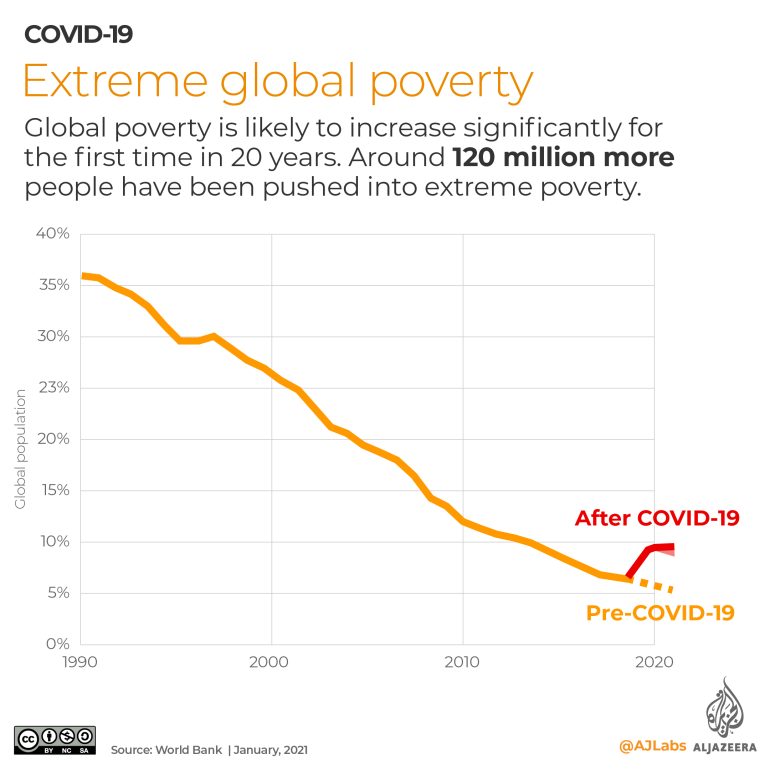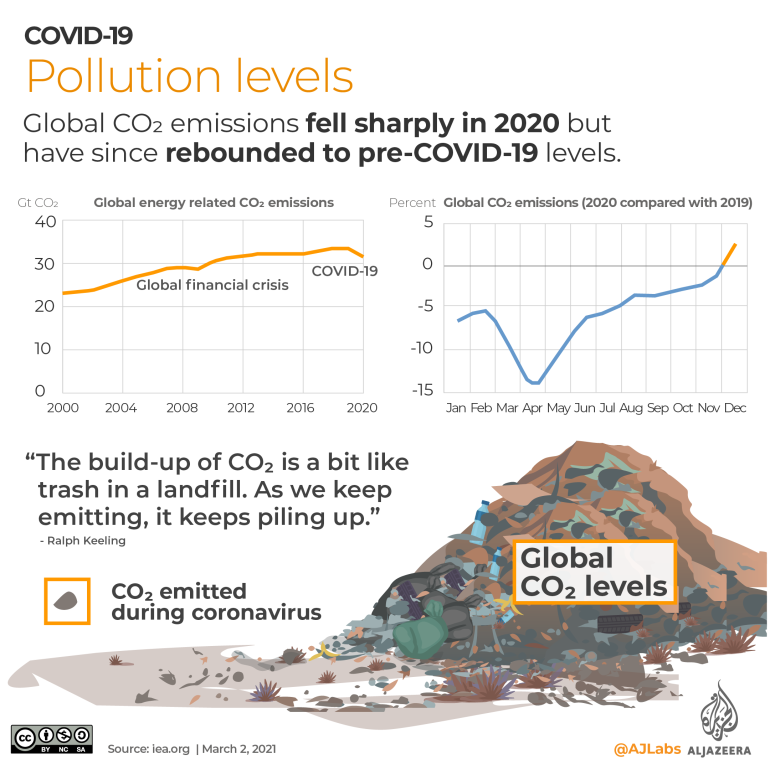How Has Art Used To Change The World
Ane twelvemonth ago, the World Health Organization (WHO) alleged COVID-xix a pandemic. The microscopic coronavirus has, in one manner or another, inverse the lives of all 7.viii billion people on Earth.
While the long-term affect of this global health crisis may take years to understand, its immediate event has already inverse the earth as we know information technology. In the following infographics, we break downwardly the latest figures and reports to help you understand the pandemic'due south global repercussions.
For each topic, we looked at the nearly complete and reliable datasets bachelor on a global level. The numbers are often presented as averages across a country, so it is important to remember that averages may mask inequalities, particularly when dealing with underreported areas or populations at take chances.
Leading causes of death
At to the lowest degree two.7 million people worldwide have died from COVID-xix. While the leading global causes of death for 2020 accept not been published notwithstanding, compared to 2019, COVID ranks among the height five biggest killers.
In 2019, 55.4 one thousand thousand people died across the globe. Center illness killed the most people (8.ix million) followed by strokes (6.ii million) and lung disease (3.2 million). Collectively these are known as non-communicable diseases, meaning they are not transmitted between people. In dissimilarity, the highly contagious coronavirus is a communicable illness.
The graphic below shows how one year of coronavirus deaths compares to the leading causes of death in 2019.

In the The states, the land with the highest number of COVID-19 deaths, data from the Centers for Disease Control and Prevention shows that the coronavirus has killed more Americans in i year (540,000) than the influenza has in the last 10 years combined (368,000).

Mental health
The WHO estimates that almost i billion people worldwide are living with a mental disorder. In 2019, 703,000 people took their own lives, making suicide the 17th-virtually common cause of death. Despite that, countries spend only most 2 percent of their national health budgets on mental health.
The UN has warned that the COVID-xix pandemic volition likely cause a long-term increase in the number and severity of mental wellness problems. The evidence regarding the mental wellness consequences of lockdowns and social distancing is still existence studied. While we take no large-scale data on the effect COVID-19 has had on mental health globally, several smaller studies (PDF) indicate higher rates of anxiety and depression.
Below are five tips past Dr Devora Kestel, director of the Department of Mental Health and Substance Corruption at the WHO, on protecting our mental wellness.

Worldwide lockdowns
Past definition, a pandemic is a worldwide spread of a disease. It is estimated that more than than two-thirds of the globe population has experienced lockdown measures, lasting from weeks to months.
According to information compiled by the Oxford COVID-xix Authorities Response Tracker, more than 100 countries and territories in 2021 accept reintroduced stay-at-home orders with some exceptions such as for essential trips, daily exercise or grocery shopping.
The graphic beneath summarises the elapsing of nationwide lockdowns over 12 months (January 16, 2020 – January 15, 2021).

Trillions lost
Co-ordinate to World Depository financial institution estimates, the global economy shrank by 4.3 percent in 2020, wiping out trillions of dollars. Countries already facing economic hardship sank farther into debt. A report by Oxfam International (PDF) estimates that it could have more than a decade for the world's poorest to recover from the economic fallout of the pandemic.
On the upside, the Globe Bank expects the global economy to expand by iv percentage in 2021 with vaccine rollouts and investments leading the recovery.
The graphic below shows the consequence COVID-19 had on the global economic system. Every major economy except for Communist china's shrank over the course of 2020. Other countries that saw their gross domestic production (Gdp) abound include Bangladesh (2 per centum), Republic of benin (2 percentage), Burundi (0.3 percent), Egypt (3.6 per centum), Federal democratic republic of ethiopia (half-dozen.1 per centum), Republic of ghana (1.i percent), Guinea (5.2 percent), Guyana (23.2 percent), Ivory Coast (1.8 per centum), Myanmar (1.7 percent), Nepal (0.ii percentage), Niger (1 percent), South Sudan (9.3 percentage), Tajikistan (ii.2 percent), Tanzania (ii.5 percentage), Turkey (0.5 per centum), Uzbekistan (0.6 percent) and Vietnam (two.8 pct).
This past no means suggests that these countries were ameliorate off afterwards the coronavirus, several of them were projected to achieve even college growth before the pandemic with otheried relying on lending to prop upward their economies.

Global poverty and unemployment
The coronavirus has unduly afflicted the poor. For the first time in 20 years, global poverty is likely to increase significantly. The World Banking concern estimates the coronavirus has pushed between 119 and 124 million people into extreme poverty, making the total number of people living on less than $1.90 a twenty-four hours to 730 million, most x percent of the world's population.

In 2020, 114 million people lost their jobs, according to the latest unemployment figures from the International Labour Organization (ILO). But official figures solitary is not enough to measure joblessness. As the ILO points out, many more workers have fallen into "economic inactivity", significant they had to withdraw from the labour force. Many more may yet be employed simply operating with reduced working hours or pay cuts.
Women and younger workers accept been amongst the hardest hit, prompting concerns over widening gender inequality and a lost generation of workers.
In addition, theUN Development Programme has warned that virtually half of all jobs in Africa could exist wiped out due to the pandemic.

The rich got richer
A report (PDF) released past Oxfam International, a UK-based charity, said the pandemic hurt people living in poverty more than than the rich. The almost severely afflicted are women, Black people, African-descendants, Ethnic peoples, and historically marginalised and oppressed communities around the world, the report said.
To put that income inequality in perspective, a written report (PDF) by Swiss Bank UBS, found that the world'due south richest people got $three.nine trillion richer between March and December 2020. The x richest billionaires made $540bn during this time.
Many of the world's richest men, including Elon Musk (United states of america), Zhong Shanshan (People's republic of china) and Mukesh Ambani (India), saw their wealth more than double since the pandemic was declared.

1.7 billion students out of schoolhouse
In 2020, schoolhouse and academy closures disrupted the education of more than i.seven billion students from 188 countries, or about 99 percent of the world's student population, co-ordinate to UNESCO.
Today, nearly 900 1000000 students, more half the world's pupil population, continue to face heavy education disruptions, ranging from schoolhouse closures in 29 countries to reduced or role-time classes in 68 others, co-ordinate to the latest data from UNESCO.

While online schooling played allowed classes to continue nearly, the UN estimates that nearly 500 million children, peculiarly in poorer countries or rural areas, accept been excluded from remote learning due to a lack of engineering science or policies.
Oxfam estimates that the pandemic will reverse the last 20 years of global progress on girls' education, farther increasing poverty and inequality.

Worst twelvemonth for air travel
In 2019, more than iv.5 billion passengers took 38 meg flights worldwide. With lockdowns and quarantines for most of 2020, many cancelled or postponed travel plans.
International passenger demand in 2020 dropped by 75.half dozen per centum compared to 2019, according to the International Air Transport Association.
Global flight-tracking service Flightradar24 too recorded a 42-percent dip in commercial flights from 2019. Many airlines were forced to operate cargo-but flights to keep supermarket shelves stocked and online orders fulfilled.

Lockdowns from space
On the left are images taken pre-lockdown, contrasted with lockdown images taken in March 2020 to testify the pandemic's effect had on cities worldwide. Unprecedented lockdowns emptied streets, disrupted travel and slowed economic activity – temporarily slashing air pollution.
Below we meet how Mecca, Wuhan and Venice all saw a precipitous turn down in visitors a few weeks into the pandemic. See satellite images from more cities here.

Pollution levels
In the showtime weeks of COVID lockdowns, there were reports of clearer and less polluted skies. For example, residents of Venice, Italy, reported clear running water in its normally humming canals for the first time in years.
Notwithstanding, this seems to have been curt-lived. A recent report past the International Energy Agency institute that while global energy-related CO2 emissions cruel overall by 5.viii percent in 2020 – the largest annual percentage decline since World War 2 – the latest data shows global CO2 pollution bounced dorsum to pre-COVID levels.
Professor Ralph Keeling, head of the Scripps CO2 programme, explained the situation back in May 2020: "People might be surprised to hear that the response to the coronavirus outbreak has not done more to influence CO2 levels. The build-upward of CO2 is a bit like trash in a landfill. As we keep emitting, it keeps piling up."

Source: https://www.aljazeera.com/news/2021/3/22/how-has-the-world-changed-since-covid-19
Posted by: woodsfambireett.blogspot.com


0 Response to "How Has Art Used To Change The World"
Post a Comment